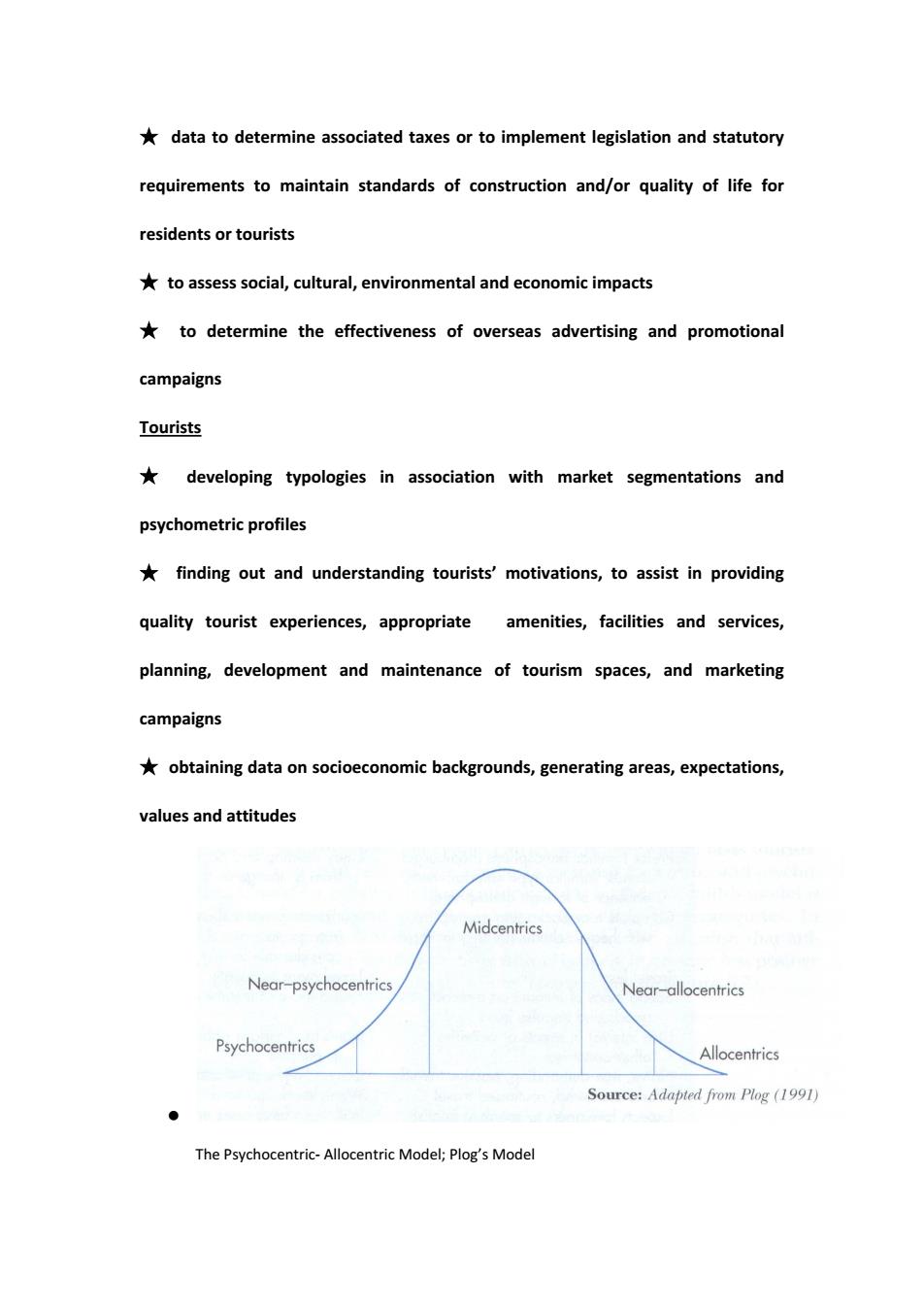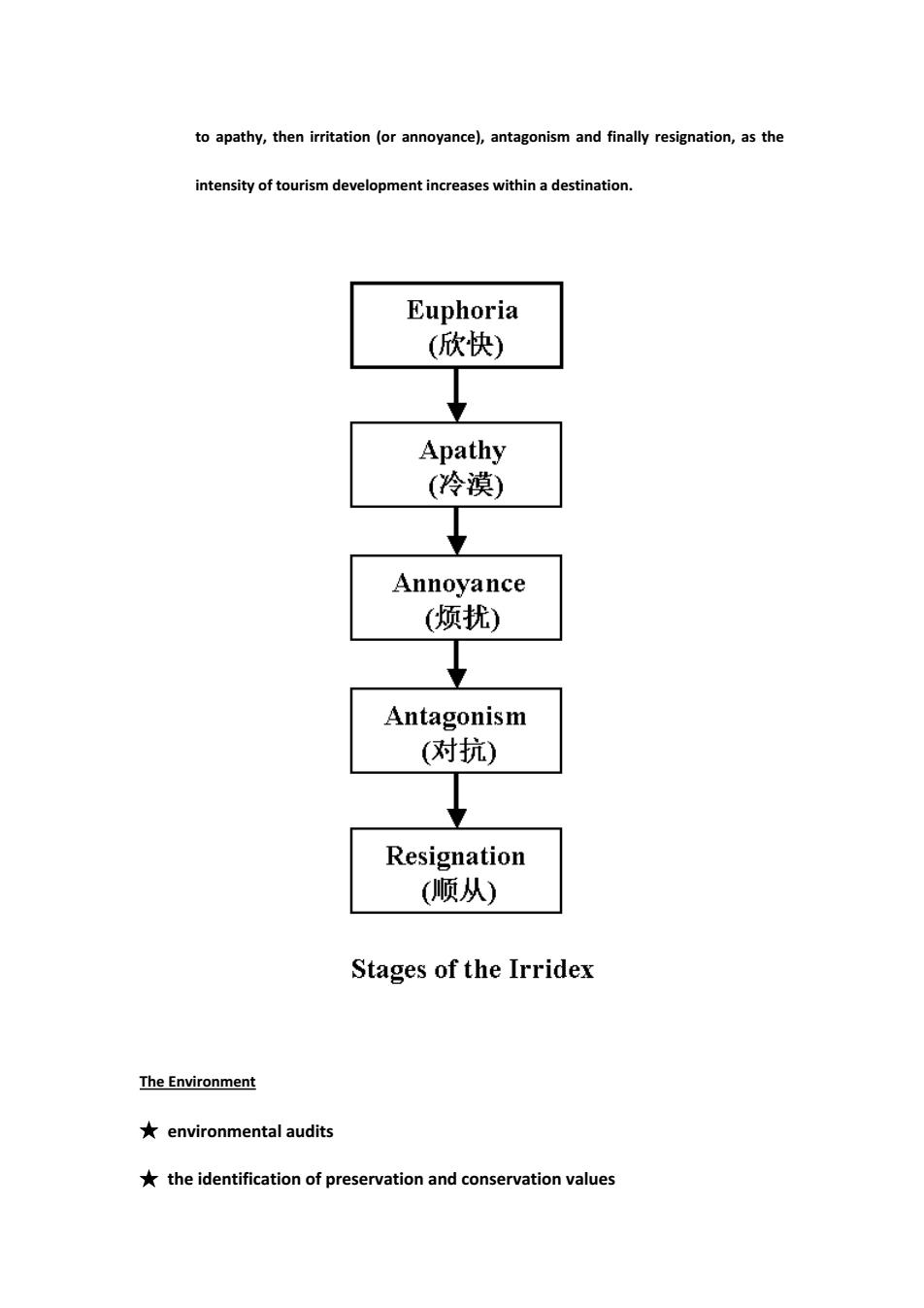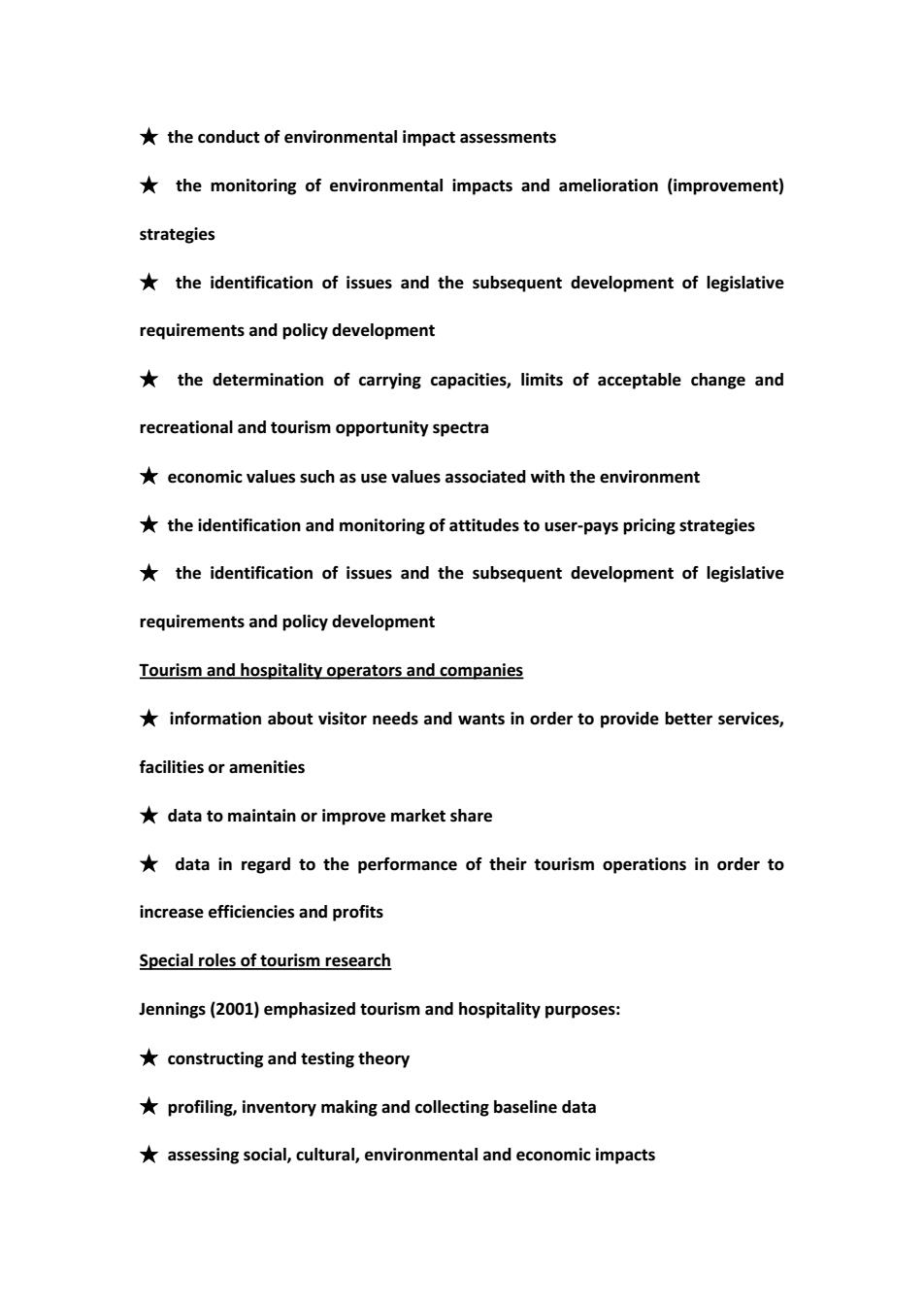
*the assessment of social,cultural,environmental and economic impacts *the resultant strategies for ameliorating(improving),amplifying,modifying or curtailing(minimizing)such impacts *the evaluation of future development needs in regard to infrastructure, superstructure,facilities and amenities *investment requirements and strategies Government *to establish data sets to monitor incoming and outgoing visitation patterns and to keep track of residents and visitors alike *to gather data on visitor numbers and activities in order to manage natural and built environments in a sustainable way to quantify visitor numbers and establish visitor patterns for planning and management purposes *data on visitor numbers to provide and maintain infrastructure and public facilities to support both local communities and visitors *to know about expenditure patterns to regulate or stimulate investment *data to determine associated taxes or to implement legislation and statutory requirements to maintain standards of construction and/or quality of life for residents or tourists *data on visitor numbers to provide and maintain infrastructure and public facilities to support both local communities and visitors to know about expenditure patterns to regulate or stimulate investment
★ the assessment of social, cultural, environmental and economic impacts ★ the resultant strategies for ameliorating (improving), amplifying, modifying or curtailing (minimizing) such impacts ★ the evaluation of future development needs in regard to infrastructure, superstructure, facilities and amenities ★ investment requirements and strategies Government ★ to establish data sets to monitor incoming and outgoing visitation patterns and to keep track of residents and visitors alike ★ to gather data on visitor numbers and activities in order to manage natural and built environments in a sustainable way ★ to quantify visitor numbers and establish visitor patterns for planning and management purposes ★ data on visitor numbers to provide and maintain infrastructure and public facilities to support both local communities and visitors ★ to know about expenditure patterns to regulate or stimulate investment ★ data to determine associated taxes or to implement legislation and statutory requirements to maintain standards of construction and/or quality of life for residents or tourists ★ data on visitor numbers to provide and maintain infrastructure and public facilities to support both local communities and visitors ★ to know about expenditure patterns to regulate or stimulate investment

data to determine associated taxes or to implement legislation and statutory requirements to maintain standards of construction and/or quality of life for residents or tourists *to assess social,cultural,environmental and economic impacts *to determine the effectiveness of overseas advertising and promotional campaigns Tourists *developing typologies in association with market segmentations and psychometric profiles *finding out and understanding tourists'motivations,to assist in providing quality tourist experiences,appropriate amenities,facilities and services, planning,development and maintenance of tourism spaces,and marketing campaigns *obtaining data on socioeconomic backgrounds,generating areas,expectations, values and attitudes Midcentrics Near-psychocentric Near-allocentrics Psychocentrics Allocentrics Source:Adapted from Plog(1991) ● The Psychocentric-Allocentric Model:Plog's Model
★ data to determine associated taxes or to implement legislation and statutory requirements to maintain standards of construction and/or quality of life for residents or tourists ★ to assess social, cultural, environmental and economic impacts ★ to determine the effectiveness of overseas advertising and promotional campaigns Tourists ★ developing typologies in association with market segmentations and psychometric profiles ★ finding out and understanding tourists’ motivations, to assist in providing quality tourist experiences, appropriate amenities, facilities and services, planning, development and maintenance of tourism spaces, and marketing campaigns ★ obtaining data on socioeconomic backgrounds, generating areas, expectations, values and attitudes The Psychocentric- Allocentric Model; Plog’s Model

Use of personality characteristics to understand tourist travel patterns Continuum from allocentrics to psychocentrics Allocentrics-Innovators who seek out new locations and activities Psychocentrics-Tradition-bound travelers who prefer traditionally popular locations and experiencing commonplace activities;desire predictability in their travels Most travelers are somewhere in between innovators and traditionalists ·The Community The needs for community research fall into two categories: 1.Research associated with community participation in tourism planning and development 2.Research to establish social and cultural impacts The community needs tourism researchers to identify community attitudes to development(irridex) assess social,cultural,environmental and economic impacts and develop strategies for sustainable tourism development *implement or review legislative requirements and inform policy development ●Doxey's irridex(怒指数)isan index of resident irritation to describe the evolutionof Irridex is a theoretical model proposing that resident attitudes evolve from euphoria
– Use of personality characteristics to understand tourist travel patterns – Continuum from allocentrics to psychocentrics Allocentrics- Innovators who seek out new locations and activities Psychocentrics- Tradition-bound travelers who prefer traditionally popular locations and experiencing commonplace activities; desire predictability in their travels Most travelers are somewhere in between innovators and traditionalists The Community The needs for community research fall into two categories: 1. Research associated with community participation in tourism planning and development 2. Research to establish social and cultural impacts The community needs tourism researchers to ★ identify community attitudes to development (irridex) ★ assess social, cultural, environmental and economic impacts and develop strategies for sustainable tourism development ★ implement or review legislative requirements and inform policy development Doxey’s irridex (激怒指数) is an index of resident irritation to describe the evolution of local attitudes. Irridex is a theoretical model proposing that resident attitudes evolve from euphoria

to apathy,then irritation(or annoyance),antagonism and finally resignation,as the intensity of tourism deve lopment increases within a destination Euphoria (欣快) Apathy (冷漠) Annoyance (烦扰) Antagonism (对抗) Resignation (顺从) Stages of the Irridex The Environment environmental audits *the identification of preservation and conservation values
to apathy, then irritation (or annoyance), antagonism and finally resignation, as the intensity of tourism development increases within a destination. The Environment ★ environmental audits ★ the identification of preservation and conservation values

*the conduct of environmental impact assessments *the monitoring of environmental impacts and amelioration(improvement) strategies *the identification of issues and the subsequent development of legislative requirements and policy development *the determination of carrying capacities,limits of acceptable change and recreational and tourism opportunity spectra economic values such as use values associated with the environment *the identification and monitoring of attitudes to user-pays pricing strategies *the identification of issues and the subsequent development of legislative requirements and policy development Tourism and hospitality operators and companies *information about visitor needs and wants in order to provide better services, facilities or amenities *data to maintain or improve market share *data in regard to the performance of their tourism operations in order to increase efficiencies and profits Special roles of tourism research Jennings(2001)emphasized tourism and hospitality purposes: *constructing and testing theory profiling,inventory making and collecting baseline data *assessing social,cultural,environmental and economic impacts
★ the conduct of environmental impact assessments ★ the monitoring of environmental impacts and amelioration (improvement) strategies ★ the identification of issues and the subsequent development of legislative requirements and policy development ★ the determination of carrying capacities, limits of acceptable change and recreational and tourism opportunity spectra ★ economic values such as use values associated with the environment ★ the identification and monitoring of attitudes to user-pays pricing strategies ★ the identification of issues and the subsequent development of legislative requirements and policy development Tourism and hospitality operators and companies ★ information about visitor needs and wants in order to provide better services, facilities or amenities ★ data to maintain or improve market share ★ data in regard to the performance of their tourism operations in order to increase efficiencies and profits Special roles of tourism research Jennings (2001) emphasized tourism and hospitality purposes: ★ constructing and testing theory ★ profiling, inventory making and collecting baseline data ★ assessing social, cultural, environmental and economic impacts